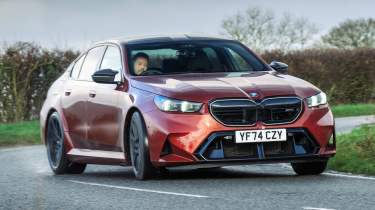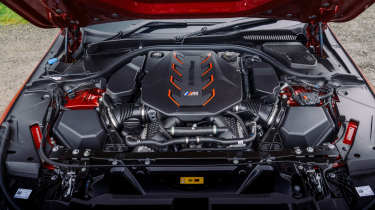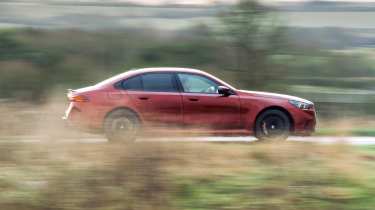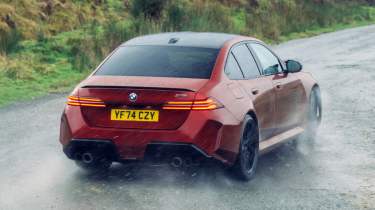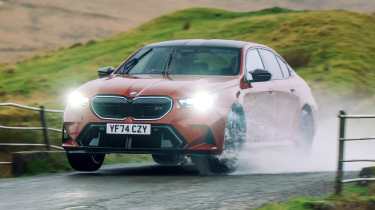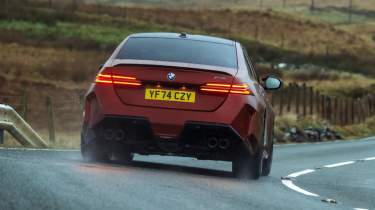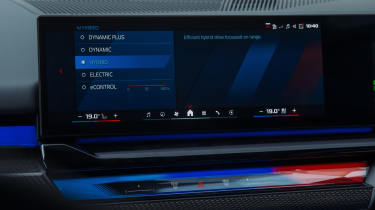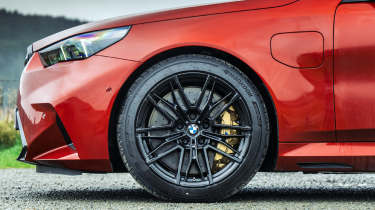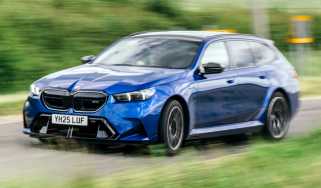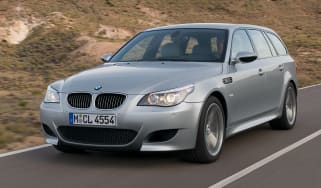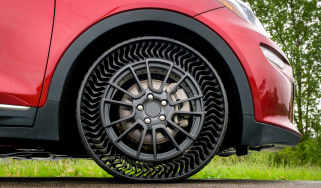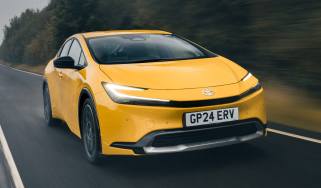BMW M5 review – it’s more powerful but is the extra weight a problem?
So much has been written about BMW’s new plug-in hybrid M5, but now it’s time for the talk to stop. Does it feel like a true M car?
Does the latest M5 - all 5.1m and 2500kg of it - manage to shrink around you and disguise its weight? Incredibly, the answer is yes, yes it does. But it’s not game, set and match yet, of course. Another crucial question still hangs in the air: is the new M5 a truly desirable M5 and one that justifies an entry price of over £111,885? Not to mention, does it outclass the 400kg lighter, much more handsome all-motor RS6 that’s still just about clinging on in 2025?
Frank Van Meel, BMW M GmbH’s boss, has been somewhat exasperated at the pervasive discourse around the new M5’s size and weight statistics. He did predict this backlash when we drove the prototype at the Salzburgring in May, having previously taken flack for proposing to make the M5 four-wheel drive. Mind, this isn’t the small matter of adding a couple of drive shafts, it’s the most radical shift in the model’s 40-year history.
That’s because the M5 has morphed into a 717bhp plug-in hybrid powerhouse of a supersaloon in G90 form, carrying more tech, complexity and weight than any of its forebears. It’s also available as a load-lugging Touring estate for the first time since the E61. It’s a remarkable car, the new M5, almost able to defy physics, but we admire it more than desire it.
Engine, gearbox and technical highlights
- 4.4-litre V8 now augmented by an electric motor
- E-motor is sandwiched between the transmission and engine
- Electrification means it’s gained over 500kg
More reviews
In-depth reviews
- BMW M5 (F10, 2011 - 2016) review: a 550bhp super saloon for £20k
- BMW M5 review – it’s more powerful but is the extra weight a problem?
- BMW 5-series review – is this still Munich’s anchor model?
- BMW M5 Competition (F90, 2017 - 2023) review – verdict, specs and prices
- BMW M5 Touring (E61, 2007 - 2010): review, specs and buying guide
Reviews
The big news, of course, is the G90’s adoption of plug-in hybrid power. Why hybrid? For one, it potentially extends the model’s life, as opposition to the EU’s 2035 outright ban on ICE car sales grows. And, as explained by BMW M boss Frank Van Meel, if you’re going to go to the trouble and weight of a mild hybrid, you might as well go the whole hog and have some proper plug-in EV ability.
Thus BMW’s familiar 4.4-litre twin-turbo V8 works with an 18.6kWh battery pack and an electric motor integrated into the eight-speed automatic gearbox.
As a result of its electrification, the M5 is quite heavy. At 2435kg it’s 540kg heavier than the outgoing M5 Competition and over 600kg more than our favourite F90, the M5 CS. The Touring, meanwhile, is a 2550kg car. To manage all that mass the M5 has a comprehensively reworked chassis, including wider tracks, staggered 20- and 21-inch wheels and tyres, and optional carbon ceramic brakes.
Drive is sent to all four wheels through an M xDrive system with an active rear differential. The new M5 also features BMW M’s first deployment of active rear-wheel steering, which counter-steers the rears for agility at low speed and parallel steers them at higher speeds for stability.
The M5’s suspension kinematics are bespoke, and its M Servotronic variable ratio steering rack is rigidly mounted to the subframe for more accuracy and feel. M-tuned adaptive dampers are standard fit.
Typical of an M car, there’s a huge variety of parameters to adjust if you delve into the M5’s drive mode menu. The dampers, steering, four-wheel drive system, regenerative braking and even the feel of the brake pedal itself can be tweaked, along with the energy strategy and delivery from the hybrid powertrain.
Power, torque and 0-62mph time
- Power and torque are up compared to the old M5…
- … but the power-to-weight ratio is lower…
- … and the 0-62mph time is slower
The M5’s hybrid-assisted V8 makes it the most powerful version yet. On its own the V8 generates 578bhp (38bhp less than the outgoing F90 M5 Competition) and 553lb ft of torque, with the 197bhp e-motor boosting the total to 717bhp and 738lb ft.
Those are bigger numbers than you get from an original Lamborghini Aventador, but in terms of pure acceleration, the G90 isn’t the giant leap on from the F90 that you might expect. Thank the weight penalty of the hybrid system for that. In fact, the G90’s power-to-weight ratio of 299bhp/ton is actually lower than the F90's figure of well over 300bhp/ton.
BMW M5 (2025, G90) specs
| Engine | V8, 4395cc, twin-turbo, plus 145kW e-motor |
|---|---|
| Power | 717bhp |
| Torque | 737lb ft |
| Weight | 2435kg (299bhp/ton) |
| Tyres as tested | Michelin Pilot Sport S 5 |
| 0-62mph | 3.5sec |
| Top speed | 155mph (189mph optional) |
| Basic price | £111,885 |
The saloon hits 62mph in 3.5sec, with the Touring a tenth slower. That’s fast by any stretch, but a little shy of the F90 Competition’s 3.3sec time. Top speed is limited to 155mph, or 189mph if you spec the optional M Driver’s Package. For reference, Audi’s RS7 Performance covers the 62mph sprint a tenth quicker, with the limiter also calling time at 189mph if you tick the correct options.
Performance, ride and handling
- Responsive thanks to instant electric shove
- Hides its size and weight remarkably well
- Not as engaging or thrilling as predecessors
When you’re not timing it on a drag strip, the G90 feels every bit as explosive as an M5 should. Plant the throttle and it snaps forwards immediately, the instant torque of the electric motor overcoming the car’s inertia in a blink before the V8’s turbos spool up and it joins the charge. Initially, you can’t comprehend how suddenly the M5 responds to a snap-opened throttle, how its mass and inertia are cast aside. You need to recalibrate for how much pace you can pick up between corners, and what kind of overtakes are possible.
The drivetrain feels monumental and remarkably linear through the rev range, and the integrated electric motor has been tuned specifically to complement the delivery of the V8. In a straight line, at least, the thrust goes some way towards hiding the fact that you’re driving a near 2.5-ton saloon.
The M5 feels like a big car straight away, its widened hips filling narrow lanes, but you soon discover that it responds with a crisp, clean accuracy that’s unexpected for such a substantial car. The first time you steer into a turn you unconsciously build in a bit of a margin, assuming, based on your knowledge of its mass and its size, that it will take a moment to respond. Only it doesn’t. It steers cleanly and quickly, changing tack with an alacrity that seems to defy physics.
It can almost feel too eager; arriving hard on the brakes on track and tipping it into tight corners, the way it rotates so keenly can take you by surprise. It’s also generously tyred, with 285/40 ZR20s on the front and 295/35 ZR21s at the rear, with our test car fitted with Michelin’s Pilot Sport S 5.
On the road in a straight line, waggle the wheel and you can feel that brightness of response but drive normally with measured inputs and the M5 tacks cleanly and precisely into turns. It feels like M engineers have given the car all the agility it should ever need but for everyday road driving has created a zone of calm around the steering’s centre, a place where you can work in a relaxed way.
It feels wieldy with well-judged efforts, lovely linearity and a decent sense of what the front is doing, which is mostly going exactly where it’s pointed. There’s no understeer until you go hunting for it, getting on the throttle sooner and sooner in tight corners until finally the front Michelins squeal a little wide.
The steering is one of three key things that make this a much easier M5 to drive briskly than you might expect, the other two being superbly judged braking and excellent damping. The brake pedal gives reassuring response from the top of its travel without over-delivering, so the car never feels like it’s running away from you, and when you press harder it has superb feel in its mid-travel so you can easily modulate the pressure to get the exact level of retardation you want. This was with the optional carbon-ceramic brakes costing £8850, which seems like a good investment.
The good thing is that in its base settings, with everything in ‘Comfort’, the car’s dynamic composure feels unshakeable. There are many modes, of course, many tuneable features so you can adjust the car to your taste, ramp things up, though on the road there isn’t much need for tighter damping. Shifting steering up to Sport increases the efforts but is perhaps less linear, while the Sport setting for brake feel was more useful, giving a stronger top-of-the-pedal response. Set the powertrain to Sport or Sport Plus and you get everything the V8 and electric motor can give, all the time, and the kick in the back is noticeably more savage.
The MDM setting for the four-wheel drive system frees up the M5 to deliver more traditional M car thrills, by sending more drive to the rear. In other four-wheel drive M models it’s the setting of choice for setting lap times, giving an adjustable but effective dynamic balance. On the road in the M5 you can feel the shift, the rear squirming as you accelerate hard out of turns, while in the wet it’s all a bit snappy. Two-wheel drive? A challenge, for sure.
As ever, you can go ‘a la carte’ and configure profiles for the M1 and M2 shortcut buttons, but there’s also an M Drive button on the centre console and a new ‘boost’ feature: pull back and hold the left-hand paddle for a few seconds and you get a shortcut to maximum standing-start performance, the head-up display announcing BOOST in capital letters, just so you know, with a count down before the feature drops out.
> BMW M3 CS Touring 2025 review – the Nürburgring’s fastest-ever estate tested
So, what about sound? Unfortunately, although it has a traditional offset crank V8, the latest M5 sounds remarkably like a flat-plane crank V8, despite the effect of piped-in character via the sound system. With EV mode and a rounded low-speed ride, the new M5 is relaxing in town. However, in some ways the extension in the other direction, beyond comfort, is illusory. The new M5 is at its best as a road car in mostly comfort settings, offering control and precision and pace that defies its mass. It doesn’t need tighter damping or sharper steering. On track with everything cranked up, its agility and composure are impressive but we can’t ever imagine wanting to track such a huge car.
Driver’s note
‘Despite its surprising agility, the new M5’s size, weight and complexity make it – for me, at least – a difficult car to fall for wholeheartedly. I’m not sure I wouldn’t have just as much fun in the previous, non-hybrid M5 on these roads. Maybe more. And I certainly would in the (admittedly exceptional) M5 CS.
‘It can play the role of a big exec saloon very well. The suspension is (mostly) supple, the steering just calm enough, and refinement is excellent in terms of both the smooth powertrain and lack of road and engine noise. You could argue that the V8 could do with a bit more noise: its power delivery is silky but it doesn’t sound particularly memorable. For once, you might actually choose to switch the enhanced M Sound setting on.
‘Even after many hundreds of miles, it feels like a car we’re still getting to know. It’s a more complex kind of M5. A compelling one, but whether it’s as compelling as M5s of old is another question. Going hybrid has given it a broader range of talents, and if it means the M5 can stick around as we know it for a while longer, it’s something to be saluted.’ – James Taylor, evo Deputy Editor
Range and efficiency
One of the major benefits of the M5’s PHEV switch is that it should be cheaper to run. That is, if you regularly keep the battery topped up to make use of the electric power on offer, rather than just using the engine to lug the heavy hybrid componentry around for comparatively little benefit. That said, the M5 does charge itself diligently in the right settings, when on a long trip that you haven’t planned properly. We took the long-term M5 Touring to Le Mans in 2025 and it delivered 116 electric miles out of a 1000 without ever being plugged in, and 26.4mpg overall. We should also clarify, it achieved that figure fully loaded with people and luggage, weighing over three tons as a result…
The official WLTP figure BMW claims for the M5 is 176mpg which isn’t likely in the real world, but making use of the battery – charging as regularly as you can – will yield the best results. In theory you can best that figure if you’re doing most of your driving in electric-only mode. Short trips that make use of its 42-mile electric range are more cost-effective than an equivalent pure-petrol supersaloon.
In terms of consumables, the M5’s epic performance and weight will surely take a toll on the brakes and tyres. Direct replacements for M5’s Michelins aren’t available yet, but expect a full set to cost somewhere around £1500.
Interior and tech
- Not the most intuitive user interface
- Quality is reasonable
- Spacious and comfortable
Compared to the previous M5, the G90’s interior is more minimalist and more tech heavy. There’s a bank of physical controls on the centre console for accessing drive modes and media functions but very few on the dash, with BMW’s curved dual-screen infotainment system taking their place. The graphics are crisp and the response times quick, but sifting through the various menus and submenus can be fiddly while driving. Elsewhere there’s an M-specific head up display and switchable M coloured ambient lighting that seeps through the dash and door cards, which will either be striking or tacky, depending on your tastes.
Merino leather trim comes as standard, as well as four-zone climate control, heated front seats and a Bowers & Wilkins sound system. A panoramic sunroof is included, too, but if you go for the optional carbonfibre roof you’ll save 30kg and, crucially, lower the centre of mass.
> BMW M2 CS review – another all-time great M car?
The steering wheel has a flat bottom and a red 12 o’clock stripe, with further flashes of red for the M1 and M2 drive mode buttons. The seats, meanwhile, have a more generous, less defined cut than those of the M3 and M4 (and M5 CS), though you can adjust the side bolsters for a torso hug. Essentially there’s a less overtly sporty feel to the cabin, though you can order silver, orange or luminous red trim.
The Touring will be the version of choice for 717bhp furniture transportation. With the seats down it can carry up to 1630 litres, although its 500-litre boot capacity isn’t all that impressive next to the saloon’s 466. In fact, the smaller M3 Touring has just as much load space with the seats up.
Price and rivals
At £111,885, the saloon is no more expensive than the previous M5 Competition, which seems like good value given how much more tech is crammed in. Oddly, the new M5 doesn't have an awful lot of competition just yet, with Audi and Mercedes-AMG yet to unveil their new generation hybridised alternatives. The V8-powered Mercedes-AMG E63 is now off sale, with only the £92,140, 577bhp E53 hybrid available. Audi’s RS7 is now sadly off-sale, with a hybridised equivalent set to debut in the next two years. From further in the left field is the Porsche Panamera Turbo E-Hybrid, against which we tested the new M5. Much more expensive it may be but it's certainly comparable in terms of performance and mass. For closer to M5 money (but still £131k+), you'll need to settle for the less powerful but lighter Panamera GTS.
The M5 Touring, meanwhile, starts from £113,885 and went straight into battle with Audi’s RS6 Performance, though it too is not long for this world, having been removed from Audi’s configurator in the UK.
BMW M5 versus rivals
| Model | Power | Torque | Weight | 0-62mph | Top speed | Price |
|---|---|---|---|---|---|---|
| Mercedes-AMG E53 | 577bhp | 553lb ft | 2315kg-2380kg | 3.8 - 4.1sec | 155-174mph | From £92,140 |
| BMW M5 | 717bhp | 737lb ft | 2435kg | 3.5sec | 155-189mph | From £111,885 |
| Porsche Panamera Turbo E-Hybrid | 671bhp | 686lb ft | 2360kg | 3.2sec | 196mph | From £151,500 |
